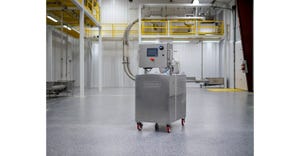March 9, 2020

The first question I ask when arriving on site to investigate a fire or explosion incident involving a combustible powder or dust is, “What changes have you made recently with regard to your process/equipment?” I am often met with curious glances. About 50% of the time I find out that a change was made, and this change ultimately resulted in, or contributed to, the incident. Sometimes seemingly innocuous changes to a process or process equipment can result in unanticipated consequences. Relocation of a level sensor in a bin, below a vertical ribbon blender, resulted in catastrophic failure of the blender and a flash fire in the bin. A metal powder manufacturing plant commissioned a new line to manufacture an iron alloy and during the second batch of packaging a flash fire occurred destroying the entire packaging line. These are just a couple of examples of what can happen, if the ramifications of the changes, other than replacement in kind, are not considered.
The change may include something as benign as process materials sourcing from a different manufacturer, the same raw material manufacturer using new methods to produce the product, or changes in formulation.
Care must be taken when substituting raw materials. There have been cases where a seemingly equivalent material substitution resulted in a large change in the process hazard. Not all safety properties of a material are characterized in, for example, a safety data sheet. Chemical composition might be identical, but quite different static ignition hazards, due to bulk resistivity and charge relaxation rate, can appreciably increase the hazard.
Click here for information about the upcoming International Powder & Bulk Solids Conference/Exhibition
Some fire and explosion protection systems can also introduce additional hazards into the process environment. These hazards can include, but are not limited to, energy in suppression canisters, asphyxiation hazards from inert gases, and mechanical laceration/amputation hazards from explosion isolation systems. While these are not fire or explosion hazards, they should be addressed as part of the management of change review.
The NFPA voluntary consensus standards for combustible dust require that management systems be in place in order to effectively manage the risk of combustible dust fires, flash fires, and explosions. There are a number of management systems that are required to be implemented including, the Management of Change program.
Many companies have Management of Change (MOC) programs in place which address sustainability, quality control, and even new engineering projects, but do not have a program that addresses changes to a process or equipment, other than replacement in kind. NFPA 652, The Standard on Fundamentals of Combustible Dust provides requirements for MOC programs. The latest revisions of the commodity-specific standards have similar requirements, for example, NFPA 61 (agricultural and food processing), NFPA 484 (combustible metals), NFPA 654 (general combustible dust) and NFPA 664 (wood processing and woodworking) standards.
Written procedures should be established and implemented to manage proposed changes to process materials, staffing, job tasks, technology, equipment, procedures, and facilities. The procedures should ensure that the following are addressed prior to any change: (1) The basis for the proposed change; (2) Safety and health implications; (3) Whether the change is permanent or temporary, including the authorized duration of temporary changes; (4) Modifications to operating and maintenance procedures; (5) Employee training requirements; (6) Authorization requirements for the proposed change; (7) Results of characterization tests used to assess the hazard, if conducted.
A tool should always be used to assess the potential safety hazards that may be associated with the change. This tool may be as simple as a safety checklist, a more detailed “what-if” checklist, or a full hazard and operability study (HAZOP) designed to identify and evaluate potential effects of the change and provide safety measures to mitigate it.
Personnel involved in the management of change exercise must be experienced in the process/equipment and have a fundamental background on the hazards associated with solid particulate combustible materials, including conditions that can lead to the fire, flash fire, and explosions. In some cases, outside help may be required. Don’t put yourself at risk for an unplanned event at your plant. Ensure that you have a robust MOC program in place to effectively manage your operations, when changes are made.
Steven Luzik is a senior process safety specialist for DEKRA. He has more than 30 years of experience in the field of combustible dust/powder fire and explosion hazard identification, risk management strategies, and incident investigations. For ore information, contact him at [email protected].
Articles that may interest you:
What You Need to Know About the New Edition of NFPA 652
Extracting Combustible Dusts at the Source
How to Use Dust Explosion Test Data to Ensure Facility Safety
Explosion Containment: A Comparison
You May Also Like


